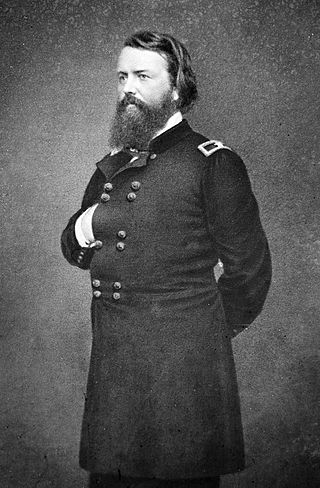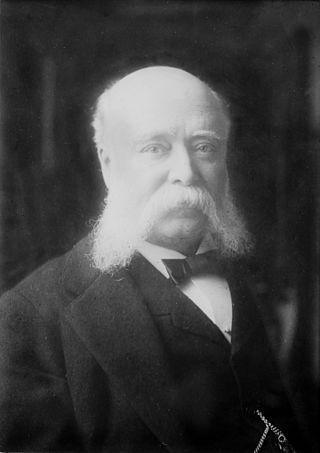
The Reconstruction era was a period in United States history following the American Civil War, dominated by the legal, social, and political challenges of abolishing slavery and reintegrating the former Confederate States of America into the United States. During this period, three amendments were added to the United States Constitution to grant equal civil rights to the newly freed slaves. Despite this, former Confederate states often used poll taxes, literacy tests, and intimidation to control people of color.

Edward Richard Sprigg Canby was a career United States Army officer and a Union general in the American Civil War. He served as a military governor after the war.

John Pope was a career United States Army officer and Union general in the American Civil War. He had a brief stint in the Western Theater, but he is best known for his defeat at the Second Battle of Bull Run in the East.

The Fifth Military District of the U.S. Army was one of five temporary administrative units of the U.S. War Department that existed in the American South from 1867 to 1870. The district was stipulated by the Reconstruction Acts during the Reconstruction period following the American Civil War. It covered the states of Texas and Louisiana.
The Reconstruction Acts, or the Military Reconstruction Acts, were four statutes passed during the Reconstruction Era by the 40th United States Congress addressing the requirement for Southern States to be readmitted to the Union. The actual title of the initial legislation was "An act to provide for the more efficient government of the Rebel States" and was passed on March 4, 1867. Fulfillment of the requirements of the Acts was necessary for the former Confederate States to be readmitted to the Union from military and Federal control imposed during and after the American Civil War. The Acts excluded Tennessee, which had already ratified the 14th Amendment and had been readmitted to the Union on July 24, 1866.

John McAllister Schofield was an American soldier who held major commands during the American Civil War. He was appointed U.S. Secretary of War (1868–1869) under President Andrew Johnson and later served as Commanding General of the United States Army (1888–1895).

Wager Swayne was a Union Army colonel during the American Civil War and was appointed as the last major general of volunteers of the Union Army. Swayne received America's highest military decoration the Medal of Honor for his actions at the Second Battle of Corinth. He also was effectively the military governor of Alabama from March 2, 1867, to July 14, 1868, after the passage of the first Reconstruction Act by the U.S. Congress until Alabama was readmitted to the Union. Robert M. Patton remained the nominal governor during this period but as the local army commander, Swayne controlled the State government. During the Reconstruction era, Swayne oversaw the Freedmen's Bureau in Alabama and helped establish schools for African Americans in the state. He was the first person born after Alabama statehood, to govern the state.

The Third Military District of the U.S. Army was one of five temporary administrative units of the U.S. War Department that existed in the American South. The district was stipulated by the Reconstruction Acts during the Reconstruction period following the American Civil War. It comprised Georgia, Florida and Alabama and was headquartered in Atlanta.

Thomas Howard Ruger was an American soldier and lawyer who served as a Union general in the American Civil War. After the war, he was a superintendent of the United States Military Academy at West Point, New York.

The First Military District of the U.S. Army was one of five temporary administrative units of the U.S. War Department that existed in the American South. The district was stipulated by the Reconstruction Acts during the Reconstruction period following the American Civil War. It only included Virginia, and was the smallest of the five military districts in terms of size. The district was successively commanded by Brigadier General John Schofield (1867–1868), Colonel George Stoneman (1868–1869) and Brigadier General Edward Canby (1869–1870).

The Fourth Military District of the U.S. Army was one of five temporary administrative units of the U.S. War Department that existed in the American South. The district was stipulated by the Reconstruction Acts during the Reconstruction period following the American Civil War. It included the occupation troops in the states of Arkansas and Mississippi. At various times, the district was commanded by generals Edward Ord, Alvan Cullem Gillem, and Adelbert Ames.

During the American Civil War, North Carolina joined the Confederacy with some reluctance, mainly due to the presence of Unionist sentiment within the state. A popular vote in February, 1861 on the issue of secession was won by the unionists but not by a wide margin. This slight lean in favor of staying in the Union would shift towards the Confederacy in response to Abraham Lincoln's April 15 proclamation that requested 75,000 troops from all Union states, leading to North Carolina's secession. Similar to Arkansas, Tennessee, and Virginia, North Carolina wished to remain uninvolved in the likely war but felt forced to pick a side by the proclamation. Throughout the war, North Carolina widely remained a divided state. The population within the Appalachian Mountains in the western part of the state contained large pockets of Unionism. Even so, North Carolina would help contribute a significant amount of troops to the Confederacy, and channel many vital supplies through the major port of Wilmington, in defiance of the Union blockade.

Stewart Lyndon Woodford was an American attorney and politician who served as a member of the United States House of Representatives and the lieutenant governor of New York.

Louisiana was a dominant population center in the southwest of the Confederate States of America, controlling the wealthy trade center of New Orleans, and contributing the French Creole and Cajun populations to the demographic composition of a predominantly Anglo-American country. In the antebellum period, Louisiana was a slave state, where enslaved African Americans had comprised the majority of the population during the eighteenth-century French and Spanish dominations. By the time the United States acquired the territory (1803) and Louisiana became a state (1812), the institution of slavery was entrenched. By 1860, 47% of the state's population were enslaved, though the state also had one of the largest free black populations in the United States. Much of the white population, particularly in the cities, supported slavery, while pockets of support for the U.S. and its government existed in the more rural areas.

The impeachment of Andrew Johnson was initiated on February 24, 1868, when the United States House of Representatives passed a resolution to impeach Andrew Johnson, the 17th president of the United States, for "high crimes and misdemeanors". The alleged high crimes and misdemeanors were afterwards specified in eleven articles of impeachment adopted by the House on March 2 and 3, 1868. The primary charge against Johnson was that he had violated the Tenure of Office Act. Specifically, that he had acted to remove from office Edwin Stanton and to replace him with Brevet Major General Lorenzo Thomas as secretary of war ad interim. The Tenure of Office Act had been passed by Congress in March 1867 over Johnson's veto with the primary intent of protecting Stanton from being fired without the Senate's consent. Stanton often sided with the Radical Republican faction and did not have a good relationship with Johnson.

The presidency of Andrew Johnson began on April 15, 1865, when Andrew Johnson became President of the United States upon the assassination of President Abraham Lincoln, and ended on March 4, 1869. He had been Vice President of the United States for only six weeks when he succeeded to the presidency. The 17th United States president, Johnson was a member of the Democratic Party before the Civil War and had been Lincoln's 1864 running mate on the National Union ticket, which was supported by Republicans and War Democrats. Johnson took office as the Civil War came to a close, and his presidency was dominated by the aftermath of the war. As president, Johnson attempted to build his own party of Southerners and conservative Northerners, but he was unable to unite his supporters into a new party. Republican Ulysses S. Grant succeeded Johnson as president.

After the Civil War, Ulysses S. Grant spent four years as head of the United States Army in peacetime. With his defeat of Robert E. Lee and the Confederacy, Grant was the most popular man in the country. As the Civil War ended Grant turned his attention to the Plains in the American West where there were numerous conflicts between white settlers, railroads, and Native Americans that resulted in wars between the Natives and the U.S. military. While the attempted Fenian invasion of Canada and French intervention in Mexico took some of his time, Grant's biggest focus was on Reconstruction of the defeated Southern states. Grant found himself caught between President Andrew Johnson, who wanted leniency to the South and a continuation of the social structure there, and the Radical Republicans in Congress, who wanted harsher punishment to rebel leaders and more government assistance to the freed slaves. Grant preserved his popularity and authority throughout the crisis that culminated in Johnson's impeachment. In 1868, the Republicans nominated Grant for president, and he won easily over his Democratic challenger.
The Department of the South was a military department of the United States Army that existed in several iterations in the 19th century during and after the American Civil War.

Following the end of the American Civil War, five Reconstruction Military Districts of the U.S. Army were established as temporary administrative units of the U.S. War Department in the American South. The districts were stipulated by the Reconstruction Acts during the Reconstruction period following the American Civil War.
Eleven articles of impeachment against United States President Andrew Johnson were adopted by the United States House of Representatives on March 2 and 3, 1868 as part of the impeachment of Johnson. An impeachment resolution had previously been adopted by the House on February 24, 1868. Each of the articles were a separate charge which Johnson would be tried for in his subsequent impeachment trial before the United States Senate.














